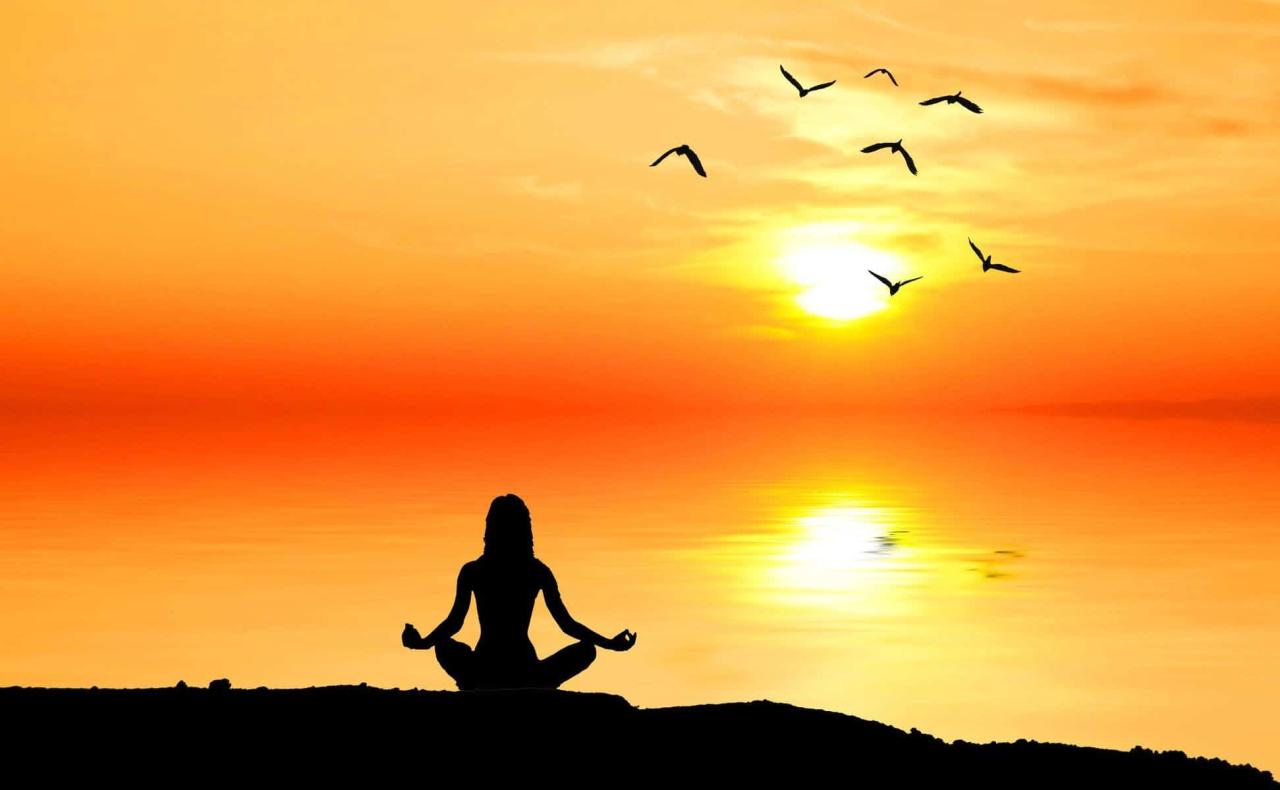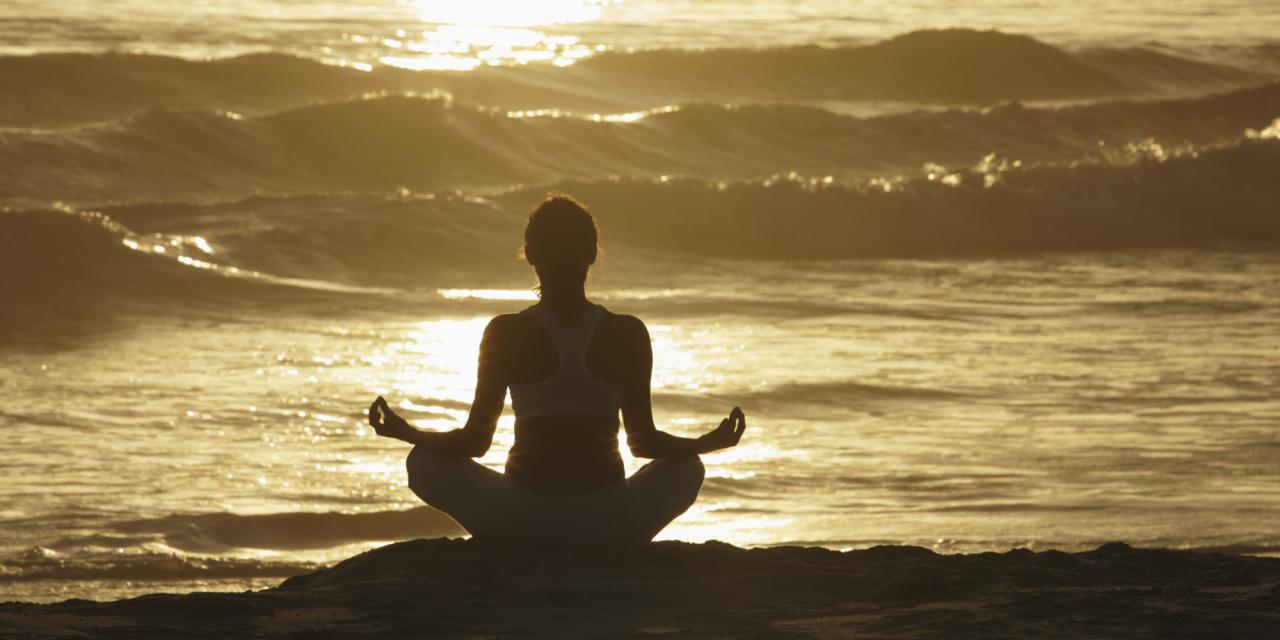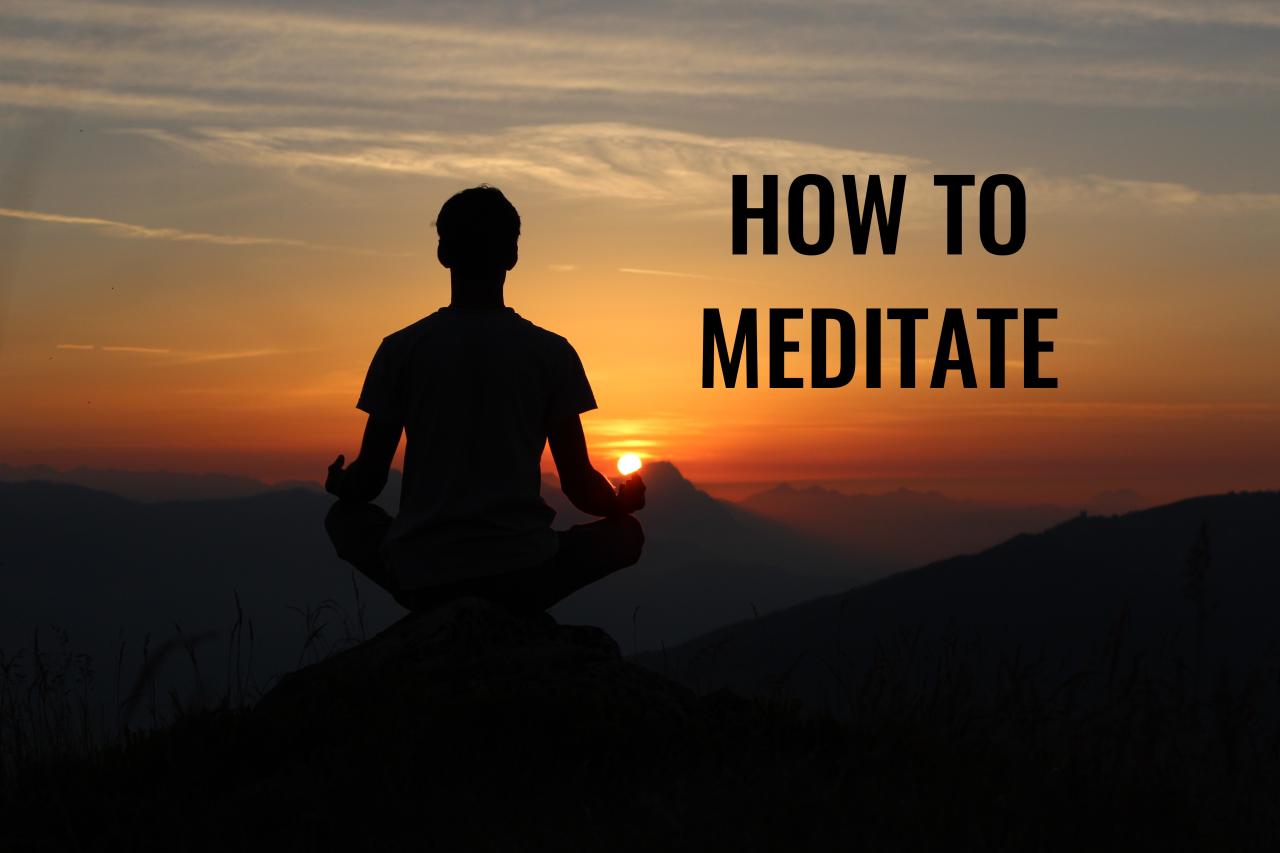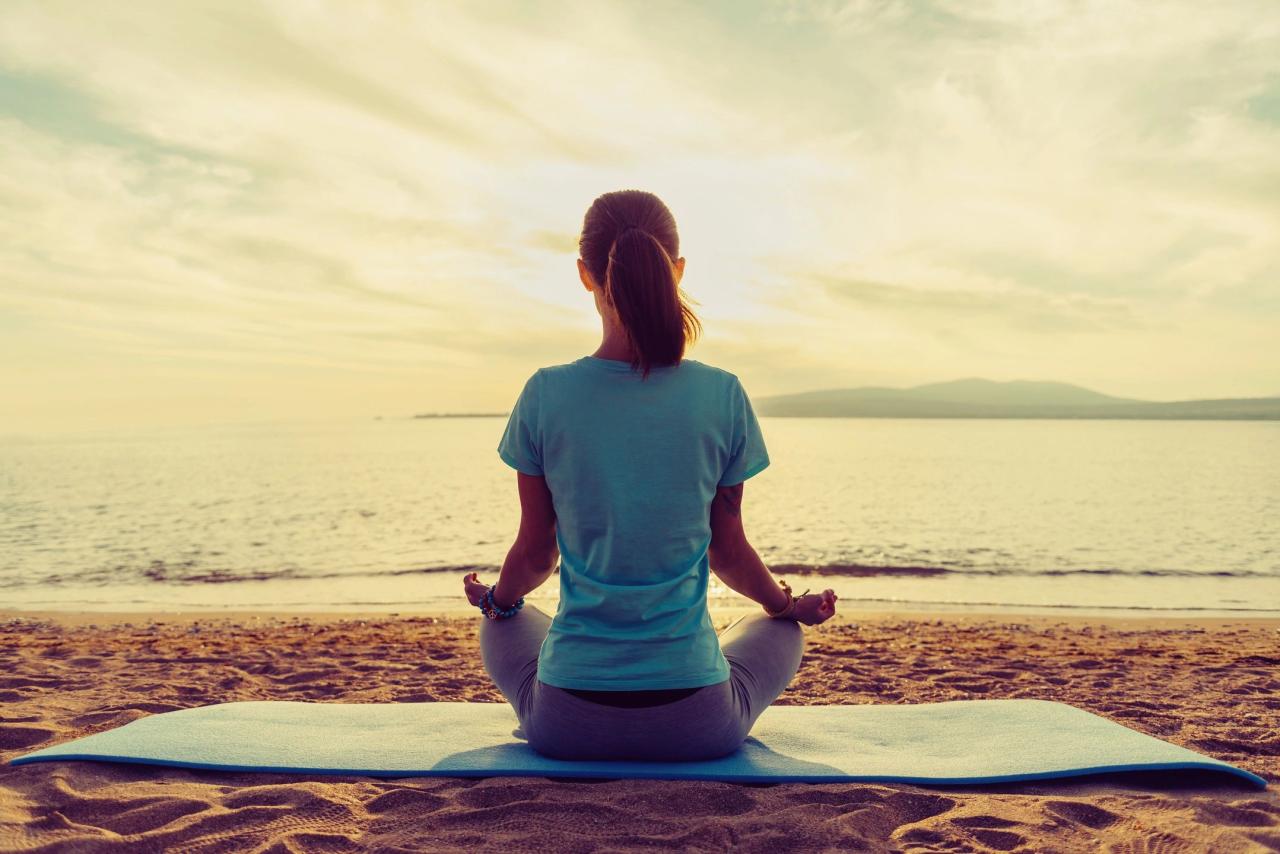How to meditate for visualization opens the door to harnessing the power of the mind to create vivid mental images that enhance focus, relaxation, and personal growth. This practice combines the calming aspects of meditation with the creative process of visualization, offering a unique approach to achieving mental clarity and emotional balance. When done correctly, it can significantly enrich your meditative routine and support your goals, whether they involve relaxation, goal setting, or healing.
This guide provides comprehensive steps on preparing your environment, employing effective techniques, focusing on specific themes, and tracking your progress to maximize the benefits of visualization meditation. By integrating these practices into your daily routine, you can unlock the full potential of your imagination and cultivate a more mindful, centered life.
Introduction to Meditation for Visualization

Meditation for visualization is a focused practice that harnesses the power of mental imagery to achieve clarity, relaxation, and personal growth. Unlike traditional meditation techniques that often emphasize breath awareness or physical sensations, visualization meditation directs the mind toward creating vivid mental images aligned with specific intentions or goals. This practice not only enhances mental focus but also activates the subconscious mind, fostering positive change and heightened self-awareness.
Engaging in visualization meditation involves cultivating a calm, receptive state of mind where detailed mental images can be vividly constructed and explored. This technique is widely used in areas such as goal setting, stress reduction, and enhancing creativity. Its unique approach bridges mindfulness with imaginative visualization, making it an effective tool for manifesting desires and reinforcing positive mental pathways.
Fundamentals of Visualization Meditation
Visualization meditation is rooted in the principle that the mind responds strongly to images and symbols. When practiced regularly, it can influence both the subconscious and conscious mind, facilitating a deeper connection to one’s intentions. The process typically involves finding a comfortable seated position, closing the eyes, and gradually directing attention inward. The practitioner then constructs detailed images that relate to specific goals or positive outcomes, engaging all senses to make the visualization as real as possible.
The clarity and consistency of the mental images are fundamental to the effectiveness of this practice. It encourages a gentle focus on the details—such as colors, textures, sounds, and smells—helping to deepen the immersive experience. Over time, this practice can strengthen the mind’s ability to bring about the desired changes by fostering a sense of confidence, motivation, and emotional alignment.
Differences from Other Meditation Techniques
While many meditation methods focus on observing thoughts, breathing patterns, or physical sensations, visualization meditation emphasizes creating and maintaining vivid mental images. This targeted approach makes it particularly suitable for individuals seeking to manifest goals, improve performance, or explore creative ideas. Unlike mindfulness meditation, which encourages non-attachment to thoughts and sensations, visualization actively engages the imagination as a tool for personal development.
Furthermore, visualization meditation often involves guided imagery or affirmations that reinforce the desired outcome, making it more goal-oriented. This distinction allows practitioners to harness the power of their imagination consciously, transforming abstract thoughts into tangible mental representations that influence feelings, behaviors, and perceptions.
Benefits of Incorporating Visualization into Meditation Routines
Integrating visualization into meditation can yield numerous benefits that enhance overall well-being and personal achievement. Below are some key advantages:
| Benefit | Description |
|---|---|
| Enhanced Focus and Concentration | Visualization trains the mind to stay engaged with specific images, sharpening attention and mental clarity. |
| Goal Achievement | By vividly imagining desired outcomes, practitioners reinforce their commitment and motivation to realize those goals. |
| Stress Reduction and Emotional Balance | Creating peaceful, positive images can alleviate anxiety and promote relaxation, contributing to emotional stability. |
| Boosted Creativity and Problem Solving | The imaginative aspect of visualization fosters innovative thinking and helps in exploring new solutions to challenges. |
| Manifestation of Desires | |
| Self-Confidence and Empowerment | Imagining oneself succeeding or overcoming obstacles builds self-belief and resilience. |
Incorporating visualization into meditation routines allows practitioners to leverage their innate creative power, facilitating personal growth and manifesting positive changes in various aspects of life. This practice, when combined with mindfulness and regular discipline, can profoundly enhance one’s ability to realize aspirations and cultivate a more focused, peaceful mind.
Preparing for Visualization Meditation

Creating an optimal environment and establishing proper mental and physical conditions are essential steps in preparing for effective visualization meditation. These preparations help foster a calm, focused mindset and facilitate a deeper connection with your visualizations, enhancing the overall meditation experience.
By carefully selecting your surroundings, attire, and mental state, you set the stage for a distraction-free practice that allows your imagination to flourish. Proper preparation not only improves concentration but also nurtures a sense of comfort and safety, making each session more rewarding and consistent.
Creating a Calm and Distraction-Free Environment
Establishing a serene space free from interruptions is fundamental to effective visualization meditation. This environment minimizes external distractions, helping your mind to settle and focus fully on your visualization practice. Key steps include choosing a quiet location, controlling lighting and sound, and organizing the space to promote tranquility.
- Choose a quiet, secluded area where noise and interruptions are minimal, such as a dedicated corner in your home or a peaceful outdoor spot.
- Control lighting by opting for soft, natural light or dimmed artificial lighting to foster relaxation and reduce visual distractions.
- Remove clutter and unnecessary objects from the immediate vicinity to create a clean, orderly space that promotes mental clarity.
- Use calming elements like plants, candles, or incense to enhance the atmosphere and encourage a state of serenity.
Selecting Appropriate Meditation Attire and Accessories
Wearing comfortable clothing and utilizing suitable accessories can significantly enhance your focus and comfort during visualization meditation. Clothing should facilitate ease of movement and relaxation, avoiding tight or restrictive garments. Accessories can include items that promote a sense of grounding or aid in concentration.
- Opt for loose-fitting, breathable clothing made from natural fabrics like cotton or linen to prevent discomfort during extended sessions.
- Use cushions or mats to sit comfortably, supporting proper posture and reducing physical tension.
- Consider wearing a lightweight scarf or head covering if it helps you feel more focused or shields your eyes from excess light.
- Incorporate accessories such as a meditation bracelet or mala beads that can serve as tactile anchors to maintain concentration.
Mental and Physical Preparations to Enhance Visualization Focus
Prior to beginning your meditation, engaging in specific mental and physical preparations can deepen your focus and facilitate vivid visualizations. These steps help transition your mind into a receptive state and reduce residual stress or distractions.
- Practice a few minutes of deep breathing to calm the nervous system and center your attention.
- Perform gentle stretching or body scans to release physical tension and increase bodily awareness.
- Set a clear intention or affirmation for your meditation session to direct your focus and reinforce your purpose.
- Avoid stimulating activities or screens immediately before meditation to prevent mental clutter and overstimulation.
Recommended Environment Setup
Below is a table illustrating the optimal arrangement of items in your meditation environment, aimed at fostering comfort, focus, and tranquility.
| Item | Purpose | Placement | Tips |
|---|---|---|---|
| Comfortable Chair or Cushion | Supports proper posture and comfort | On a flat, stable surface at the center of the space | Ensure it allows your spine to stay straight without strain |
| Soft Lighting | Creates a calming atmosphere | Near the meditation area, adjustable to preference | Use dimmable lamps or natural light from windows |
| Calming Elements (e.g., plants, candles) | Enhances tranquility and ambiance | Adjacent to or around the meditation station | Avoid overpowering scents; opt for subtle, natural aromas |
| Minimal Distractions | Maintains focus and mental clarity | Throughout the surrounding area | Keep electronic devices away or on silent mode |
| Accessories (e.g., mala beads, eye pillow) | Facilitates focus and relaxation | Within reach on the meditation surface | Use tactile objects that feel meaningful and grounding |
Techniques and Procedures for Visualization Meditation

Effective visualization meditation requires the use of specific techniques and structured procedures to enhance mental imagery, promote relaxation, and achieve desired mental states. Mastering these methods ensures that practitioners can deepen their experience and attain greater clarity and vividness in their visualizations.
In this section, we explore a guided step-by-step process for visualization meditation, along with methods to improve the vividness and clarity of mental images. Additionally, a comparative table of different visualization techniques provides insight into their unique features and applications.
Guided Step-by-Step Visualization Meditation Process
Following a structured sequence can greatly improve the efficacy of visualization meditation, allowing practitioners to systematically build vivid mental images and engage all senses for a more immersive experience.
- Find a Comfortable Position and Settle: Begin by seated or lying down comfortably in a quiet environment. Close your eyes gently and take a few deep breaths to relax your body and mind.
- Practice Deep Breathing: Inhale slowly through your nose, filling your lungs completely, then exhale smoothly through your mouth. Repeat this breathing pattern for 1–2 minutes to induce a calm state.
- Set an Intention or Focus: Clearly state your visualization goal, such as envisioning a peaceful place, achieving a personal goal, or visualizing energy flow. This focus directs your attention and enhances concentration.
- Create the Mental Image: Begin to visualize the scene or object related to your intention. Use detailed imagery, including colors, shapes, and movements, to make the scene as realistic as possible.
- Engage the Senses: Incorporate sensory details—imagine the sounds, smells, textures, and even tastes associated with your visualization. This multisensory engagement deepens immersion.
- Maintain and Deepen the Visualization: Continue to breathe naturally as you hold the image in your mind. If your mind drifts, gently bring your attention back to the scene without judgment.
- Conclude the Meditation: Gradually let go of the visualization, take a few deep breaths, and slowly bring your awareness back to your surroundings. Open your eyes when ready.
Methods to Enhance Vividness and Clarity of Mental Images
Enhancing the clarity and vividness of mental images involves specific techniques that improve sensory engagement and mental focus. These methods help in creating more immersive and effective visualizations, vital for manifesting intentions or achieving relaxation.
- Use of Sensory Details: Actively imagining sounds, textures, smells, and tastes associated with the scene makes the visualization more lifelike. For example, envisioning the warmth of sunlight or the scent of flowers increases realism.
- Incremental Visualization: Begin with simple images and gradually add complexity and detail. Starting with a basic shape or color before expanding to full scenes helps build vividness.
- Focus on Brightness and Color: Visualize vibrant, bright colors and dynamic contrasts. Brightness and color saturation are linked to emotional intensity and clarity in mental images.
- Utilize Guided Audio or Scripts: Listening to guided visualization recordings can provide detailed descriptions that enhance mental imagery and maintain focus during meditation.
- Practice Regularly and with Intention: Consistent practice helps strengthen neural pathways associated with imagery, making mental pictures sharper and more detailed over time.
Comparison of Visualization Techniques
| Technique | Description | Key Features | Ideal Usage |
|---|---|---|---|
| Guided Imagery | A facilitator or audio guide leads the practitioner through specific visual scenarios. | Structured, detailed descriptions, sensory engagement, supportive narration. | Beginners, stress reduction, therapeutic settings. |
| Creative Visualization | Practitioners actively imagine desired outcomes or scenarios, often with the intent to manifest goals. | Open-ended, imaginative, goal-oriented, emotionally charged. | Personal development, manifesting aspirations, motivation. |
| Body Scanning Visualization | Focuses on progressively relaxing and visualizing each part of the body, often combined with imagery of releasing tension. | Sequential, internal focus, promotes relaxation and awareness. | Stress relief, promoting physical and mental relaxation, mindfulness practice. |
By understanding and utilizing these various techniques, practitioners can tailor their visualization meditation to suit specific goals, whether seeking relaxation, personal growth, or manifestation. Each method offers unique benefits and can be combined for a more comprehensive experience.
Tips for Deepening and Enhancing Visualization
As practitioners progress in their visualization meditation practice, refining techniques to deepen mental clarity and create more vivid mental images becomes essential. These strategies help transform visualization from a simple exercise into a powerful tool for personal growth, stress reduction, and goal achievement. Enhancing your ability to maintain focus and rich sensory engagement can significantly improve the efficacy of your meditation sessions, making the experience more immersive and beneficial.
Implementing effective techniques to strengthen concentration, incorporate sensory details, and address common obstacles can lead to more consistent and profound visualization experiences. Additionally, seamlessly integrating these practices into daily routines ensures sustained progress and maximizes the benefits of meditation over time.
Strategies to Improve Mental Clarity and Concentration
Maintaining sharp focus during visualization meditation is crucial for creating detailed and lasting mental images. Several methods can assist in sharpening concentration:
- Consistent Practice: Regular meditation sessions, even if brief, build mental discipline and improve concentration over time. Setting aside a specific time each day establishes a routine that anchors your practice.
- Controlled Breathing: Deep, rhythmic breathing helps calm the mind and body, reducing mental clutter and increasing focus on the visualization process.
- Use of Focus Anchors: Employing a single point of focus, such as a mental word, phrase, or physical object, can anchor attention and prevent wandering thoughts.
- Progressive Relaxation: Relaxing muscles progressively from head to toe reduces physical tension that might distract from mental clarity, fostering better concentration.
Combining these techniques creates an environment conducive to sustained attention, allowing deeper engagement with the visualization process.
Incorporating Sensory Details for Immersive Visualizations
Adding rich sensory information makes visualizations more vivid and emotionally impactful. The inclusion of sights, sounds, smells, textures, and tastes engages multiple senses, anchoring the imagery more firmly in the mind:
- Visual Details: Focus on the colors, shapes, and movements within your mental image. For example, envision the vibrant green leaves fluttering in the breeze or the shimmering surface of a tranquil lake.
- Auditory Elements: Incorporate sounds such as the rustling of leaves, the gentle flow of water, or ambient noises relevant to the scene.
- Olfactory Cues: Imagine scents like fresh pine, blooming flowers, or the aroma of baking bread to evoke specific moods and memories.
- Tactile Sensations: Feel textures, temperature, and physical sensations, such as the warmth of sunlight on your skin or the roughness of tree bark.
- Taste Experiences: When appropriate, imagine flavors associated with the scene, like the sweetness of ripe fruit or the saltiness of the ocean breeze.
Incorporating multiple sensory details creates a multi-dimensional experience, making visualization more immersive and emotionally resonant.
Overcoming Common Obstacles in Visualization Meditation
Challenges such as wandering thoughts, impatience, or difficulty maintaining focus are common in meditation practice. Employing specific techniques can help overcome these obstacles:
- Acceptance of Wandering Thoughts: Recognize distraction without judgment. Gently redirect attention back to the visualization when your mind drifts, understanding that this is part of the process.
- Time Management: Start with shorter sessions and gradually extend duration, reducing impatience and frustration. Consistent, manageable periods foster sustained focus over time.
- Use of Guided Visualizations: Listening to guided visualization recordings can provide structure and keep the mind engaged, reducing the tendency to wander.
- Maintaining Patience: Cultivating patience allows you to accept the natural ebb and flow of attention, supporting a more relaxed and persistent practice.
Addressing these obstacles with compassion and patience enhances overall progress and deepens the meditative experience.
Integrating Visualization Meditation into Daily Routines
Seamless integration of visualization practice into daily life ensures consistency and long-term benefits. Strategies for effective incorporation include:
- Designating a Specific Time and Place: Setting aside a dedicated, quiet space and time each day creates a habit and minimizes distractions.
- Short, Regular Sessions: Even five to ten minutes daily can produce meaningful results. Consistency is more effective than longer, infrequent sessions.
- Embedding Visualization into Existing Activities: Incorporate visualization during routine moments, such as commuting, lunch breaks, or before sleep, to reinforce mental imagery and relaxation.
- Using Reminders and Triggers: Setting alarms or attaching visualization cues to existing routines helps maintain mindfulness and encourages regular practice.
By making visualization meditation a natural part of daily life, practitioners cultivate a sustained mental habit that enriches their overall well-being and personal development.
Tracking Progress and Reflecting on Visualization Practice

Maintaining an awareness of your progress is essential for cultivating effective visualization skills. By systematically documenting your experiences, insights, and outcomes, you create a valuable record that helps you identify patterns, recognize improvements, and adjust your techniques for enhanced results. Reflection not only deepens your understanding but also sustains motivation as you observe tangible growth over time. Establishing a consistent routine for tracking your visualization practice ensures a more mindful and intentional journey toward mastery.Documenting your visualization experiences is a simple yet powerful way to observe how your skills evolve.
It allows you to recognize which themes resonate most, which techniques yield deeper imagery, and how your mental clarity develops. Regular evaluation of your practice provides insight into the effectiveness of different visualization methods, enabling you to refine your approach and set achievable goals for further improvement. This ongoing process serves as both an educational tool and a source of encouragement as you witness your progress.
Methods for Journaling and Documenting Visualization Experiences
Understanding how to effectively record and analyze your visualization sessions enhances self-awareness and supports growth. Consider the following practices:
- Keeping a dedicated journal or digital document: Write detailed accounts of each session, including the date, duration, theme, sensations experienced, and emotional responses. Using prompts or guided questions can help structure your entries.
- Recording insights and reflections: Note any revelations, shifts in perception, or recurring patterns. These reflections can reveal which techniques foster deeper imagery or greater relaxation.
- Tracking physical and emotional states: Document how your body feels before and after each session to gauge the impact of visualization on your overall well-being.
To facilitate organized reflection, consider maintaining a structured table. This approach simplifies review and helps identify trends over time.
Evaluating the Effectiveness of Visualization Techniques
Assessing whether your visualization practices are fruitful involves both qualitative and quantitative methods. Regular evaluation helps you determine if your techniques are fostering the desired mental and emotional states, enhancing clarity, or contributing to personal goals such as stress reduction or goal manifestation.Methods include:
- Comparing entries over time to identify increased vividness, ease of visualization, or emotional impact.
- Noting reductions in anxiety levels or improvements in focus as measurable outcomes.
- Soliciting feedback from a trusted meditation coach or peer, if applicable, for external perspectives on your progress.
- Setting specific, measurable goals at regular intervals (e.g., visualizing a scene more vividly within two weeks) and tracking your success.
By systematically reviewing your journal entries and reflection tables, you can recognize what works best, adjust your approaches, and set realistic targets for continual growth.
Organizing Reflections with a Visualization Practice Table
Structured documentation through tables provides clarity and facilitates progress tracking. An example format includes the following columns:
| Date | Visualization Theme | Insights | Outcomes |
|---|---|---|---|
| 2024-04-01 | Imagining a peaceful forest scene | Felt more relaxed after envisioning the sound of gentle wind and rustling leaves. Vivid imagery with vibrant colors. | Reduced stress, increased mental clarity during the day. |
| 2024-04-08 | Visualizing a successful presentation | Experience of confidence-building, slight difficulty maintaining imagery initially, which improved after deep breathing. | Enhanced focus during actual presentation, feeling more prepared and calm. |
Regularly updating this table after each session helps you recognize patterns, measure progress, and celebrate achievements. Setting goals based on these reflections—such as improving vividness or reducing mental distractions—provides clear targets for advancing your visualization skills.
“Consistent reflection and structured documentation are key to transforming visualization from a simple practice into a powerful tool for personal growth and goal achievement.”
Closure

In conclusion, mastering how to meditate for visualization equips you with a powerful tool for mental and emotional development. By creating an ideal environment, applying targeted techniques, and reflecting on your progress, you can deepen your visualization practice and experience its profound benefits. Embrace this journey to enrich your mind and achieve your personal aspirations with clarity and confidence.